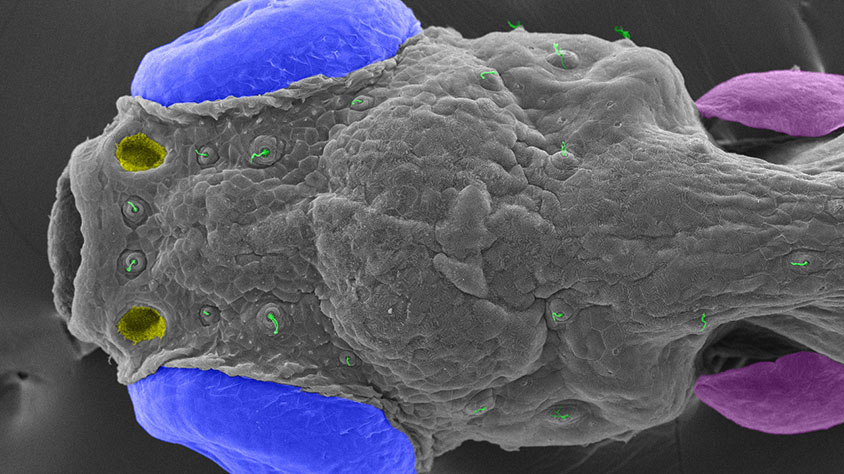
Emerging Contaminants
Understanding the human health effects of emerging contaminants including per- and poly-fluoroalkyl substances (PFAS), flame retardants, pesticides, phthalates, nanoparticles, and toxins related to cyanobacteria

Dr. Greg Cope
My research strives for a high impact program that delivers objective, science-based information to federal and state natural resource management agencies and to other policy or decision makers for effectively informing conservation, management, and recovery of imperiled species of native freshwater mollusks and fish. My research interests within this realm are in aquatic toxicology, ecology, and physiology, as well as in the transport, fate, and effects of aquatic pollutants and other human-mediated stressors such as temperature and climate change. This research utilizes sentinel aquatic organisms, biomarkers of exposure, effect, or susceptibility, or alternative toxicological models from which linkages to environmental and human health are evaluated. Major areas of research include: 1) assessment of pesticides, persistent organic pollutants, and metals in surface waters and sediment, 2) toxicological effects of waterborne and sediment-associated contaminants on fish and native mollusks (mussels and snails) in inland waterways, 3) techniques for reducing non-point source pollution from urban (e.g., polycyclic aromatic hydrocarbons) and agricultural (e.g., nutrients) watersheds, and 4) effects of non-toxicant stressors such as temperature and drought (climate change) on ecosystem function and organismal susceptibility.

Dr. Jane Hoppin
Dr. Hoppin is an environmental epidemiologist whose research group focuses on the human health effects of pesticides with a primary focus on respiratory and allergic outcomes. More recently, Dr. Hoppin has led the GenX Exposure Study, a community engaged research study to understand PFAS exposures.

Dr. Detlef Knappe
The Knappe Laboratory focuses on assessing human exposure to emerging contaminants and to develop remediation approaches to reduce human exposure. The Knappe group develops untargeted analytical approaches to identify emerging contaminants in drinking water and biological samples and is developing physical, chemical, and biological processes to remove emerging contaminants from water. Current research efforts focus on PFAS, a class of over 3,000 compounds that are associated with a wide range of adverse health impacts.

Dr. Seth Kullman
The Kullman Lab uses molecular, comparative, and functional genomic approaches to examine linkages between environmental stressors, endocrine signaling, and stem cell fate decisions during embryonic development. The laboratory has a long-standing history of employing translational fish models in mechanistic toxicity studies. The lab is currently investigating the impact of halogenated phenolic contaminants and organophosphates impact on adipogenic and osteogenic regulatory pathways, GxE effects of environmental chemicals, and immunomodulatory-metabolic effects of PFAS compounds.

Dr. Kurt Marsden
Research in Dr. Marsden’s lab is focused on understanding how both intrinsic (genetic) and extrinsic (sensory input, toxins, drugs) factors affect the formation and function of neural circuits to control behavior in zebrafish. The lab is particularly focused on how information from the environment is translated by the brain into meaningful behavioral responses. The Marsden lab uses a variety of experimental approaches including genetic manipulation with CRISPR technology, high-throughput behavioral testing, 3- and 4-D analysis of neural circuit development, simultaneous imaging of neuronal activity and behavior, and gene expression analysis.

Dr. Elizabeth Nichols
My research projects interface across disciplines of forestry, short-rotation hardwood forestry, environmental chemistry, water quality, water quantity, contaminant remediation, environmental forensics, hydrology, and community engagement. My interests include the protection of surface waters and groundwater quality and their sustainable use, ensuring forest landscapes for the future, and supporting diversity and inclusion in forestry, environmental technology, and toxicology. I am interested to collaborate at the intersections of forest systems and water quality and quantity. Recent and current research focuses on short-rotation hardwood forestry, organic contaminant forecasting for groundwater and surface water, sustainable water reuse for agriculture, managing excess water from catastrophic storms, and community engagement.

Dr. Antonio Planchart
The Planchart Lab uses the zebrafish model system to explore GxE interactions and their effects on vertebrate development. Major research questions in his lab include uncovering the role of cyanobacterial toxins on neuromuscular disorders, including ALS; the effects of cadmium exposure on neurodevelopment and metabolic syndrome; and the role of heat shock proteins in buffering environmental perturbations during vertebrate development. More recently the lab is investigating the trophic transfer of PFAS using zebrafish as a model.